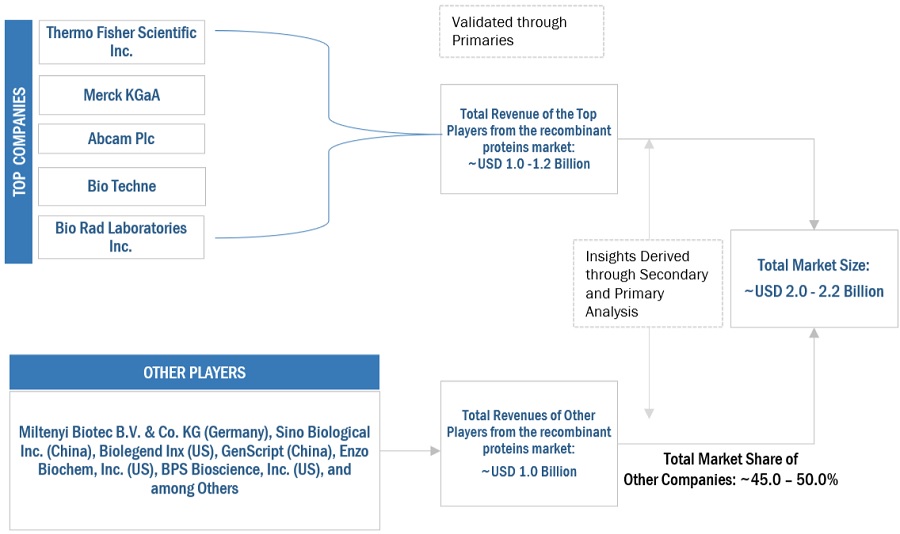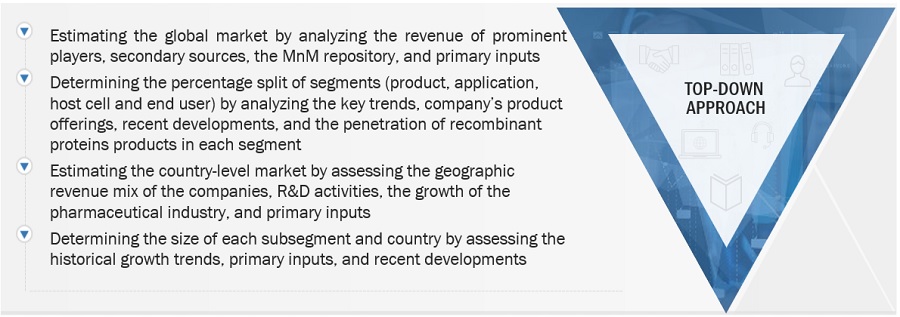This study involved four major activities in estimating the current size of the recombinant proteins market. Exhaustive secondary research was carried out to collect information on the market, its peer markets, and its parent market. The next step was to validate these findings, assumptions, and sizing with industry experts across the value chain through primary research. Both top-down and bottom-up approaches were employed to estimate the complete market size. After that, market breakdown and data triangulation procedures were used to estimate the market size of segments and subsegments.
Secondary Research
Secondary research was used mainly to identify and collect information for the extensive technical, market-oriented, and commercial study of the recombinant proteins market. The secondary sources used for this study include The Antibody Society, Pharmaceutical Research and Manufacturers of America (PhRMA), National Institutes of Health (NIH), Centers for Disease Control and Prevention (CDC), National Center for Biotechnology Information (NCBI), American Medical Association (AMA), Recombinant Antibody Network (RAN) National Cancer Institute (NCI), Association of Medical Laboratory Immunologists (AMLI), American Society of Clinical Oncology (ASCO), United States Department of Agriculture (USDA), United States Food & Drug Administration (US FDA), American Association for Cancer Research (AACR), Biomolecular Interaction Network Database, European Medicines Agency (EMA), British Society for Immunology (BSI), Institute for Molecular Medicine, Annual Reports, SEC Filings, Press Releases, Company Websites, Investor Presentations, Magazines, Paid Databases, Expert Interviews, and MarketsandMarkets Analysis ACS Journals; Corporate filings such as annual reports, SEC filings, investor presentations, and financial statements; research journals; press releases; and trade, business, and professional associations. Secondary data was collected and analyzed to arrive at the overall size of the global recombinant proteins market, which was validated through primary research.
Primary Research
In-depth interviews were conducted with various primary respondents, including key industry participants, subject-matter experts (SMEs), C-level executives of key market players, and industry consultants, among other experts, to obtain and verify the critical qualitative and quantitative information as well as assess future prospects of the market. Various primary sources from both the supply and demand sides of the market were interviewed to obtain qualitative and quantitative information. The following is a breakdown of the primary respondents:

To know about the assumptions considered for the study, download the pdf brochure
Market Size Estimation
The global size of the recombinant proteins market was estimated through multiple approaches. A detailed market estimation approach was followed to estimate and validate the value of the market and other dependent submarkets. These methods were also used extensively to estimate the size of various subsegments in the market. The research methodology used to estimate the market size includes the following:
-
The major players in the industry and market have been identified through extensive primary and secondary research.
-
The revenues generated from the recombinant proteins service business of players operating in the market have been determined through secondary research and primary analysis.
-
All percentage shares, splits, and breakdowns have been determined using secondary sources and verified through primary sources.
Global Recombinant proteins Market Size :Bottom-Up Approach

To know about the assumptions considered for the study, Request for Free Sample Report
Top-Down Approach

Data Triangulation
After estimating the overall market size from the market size estimation process, the total market was split into several segments and subsegments. To complete the overall market engineering process and arrive at the exact statistics for all segments and subsegments, data triangulation and market breakdown procedures were employed, wherever applicable. The data was triangulated by studying various factors and trends from both the demand and supply sides.
Market Definition
-
Recombinant proteins are manipulated forms of proteins that are generated by recombinant DNA technology which modifies the gene sequences. These are formed by transfecting foreign genes into a host cell. They are primarily used to produce antibodies and enzymes for disease treatment, pharmaceutical products, protein-based polymers for drug delivery, and various other research & diagnostic uses.
Key Stakeholders
-
Pharmaceutical and biotechnology companies
-
Life sciences companies
-
Academic research institutes
-
Government institutes
-
Private research firms
-
Contract Research Organizations (CROs)
-
Third-party suppliers, direct suppliers, distributors, and channel partners
-
Venture capitalists and investors
-
Market research and consulting firms
Report Objectives
-
To define, describe, and forecast the recombinant proteins market by product, application, host cell, end user, and region.
-
To provide detailed information regarding the major factors influencing the market growth (such as drivers, restraints, opportunities, and challenges)
-
To analyze the micromarkets1 with respect to individual growth trends, prospects, and contributions to the overall recombinant proteins market
-
To analyze the opportunities for stakeholders and provide details of the competitive landscape for market leaders
-
To forecast the size of the market segments with respect to five regions: North America, Europe, the Asia Pacific (APAC), Latin America (LATAM), Middle East and Africa.
-
To profile the key players and analyze their market shares and core competencies2
-
To track and analyze competitive developments, such as acquisitions, product launches, expansions, agreements, partnerships and research & development activities.
-
To benchmark players within the market using the proprietary “Company Evaluation Matrix” framework, which analyzes market players on various parameters within the broad categories of business and product excellence strategy.
Available Customizations
With the given market data, MarketsandMarkets offers customizations as per the company’s specific needs. The following customization options are available for this report:
Product Analysis
-
Product matrix, which provides a detailed comparison of the product portfolio of each company in the recombinant proteins Market



Kahlill
May, 2022
What are the growth estimates for Recombinant protein market till 2026?.
James
May, 2022
What are the key factors hampering growth of the Recombinant protein market?.
Peggy
May, 2022
Interested in data of Recombinant Protein Market, Industry Share, Size, Growth and forecasts of 2027 - 2030.
John
Dec, 2022
How big is the recombinant proteins market?.